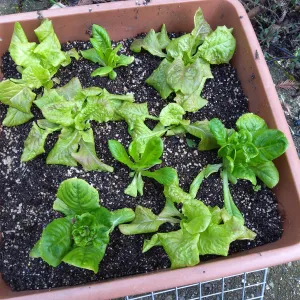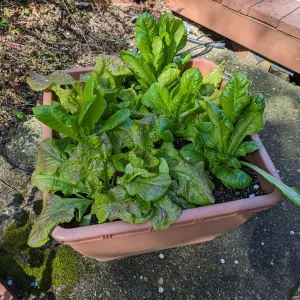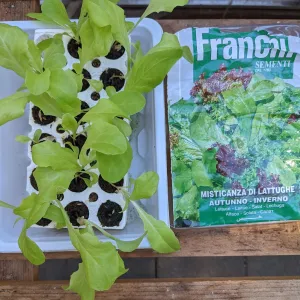Article and photos by Nanelle Jones-Sullivan
Containers
Containers allow gardeners to garden with whatever space we have available, improve accessibility for gardeners with unique needs, and are an alternative for gardeners with difficult soil conditions, such as sand, clay, soil-borne disease, or steep slopes. Containers require little weeding and cultivating and allow you to move plants with the seasons and microclimates, for example, from sun to shade.
Gardening in our area includes many microclimates, with varying amounts of ocean influence. While areas with significant ocean influence may have cool temperatures that lettuce prefers year-round, gardens further inland may find this is the ideal time to grow lettuce.
Lettuce

Many leafy greens, such as spinach, arugula, radicchio, chard, and sorrel, do well in a fall/winter container, and can be quite attractive, but lettuce refers to Lactuca sativa. Lettuce, a cool-season crop with fast germination times, as few as 45 days to harvest, and a range of textures and colors, is ideal for containers. Many can be grown closely together at first, then thinned, or harvested gradually, by picking the outer leaves of the plant while the center leaves are left to grow.
You can start with 3–4-week-old transplants or with seeds. Starting with seedlings is faster and easier, especially in hot and dry settings, but seedling choices may not offer the best options for your situation. Lettuce seeds germinate best in temperatures of 60-75 degrees F. If you are still getting temperatures above 80, you may want to start seeds inside, then move seedlings out into containers when it cools off. If planted in very early spring, it should be given full sun, and long-season lettuces should eventually be positioned so they will be shaded during the hottest part of the day.
There are many cultivars, and four major varieties of lettuce.
- Cos or Romaine lettuce grows upright and crisp and handles a bit of heat. They should be thinned to 6 to 8 inches apart. The mini-Romaine ‘Little Gem’ is said to have the best qualities of Romaine and butterhead.
- Butterhead or Bibb lettuces are loose-heading types that mature early into small heads with ruffled outer leaves surrounding a soft heart. They are appreciated for their sweet, tender leaves.
- ‘Crisphead’ is also known as iceberg, often difficult to grow because it requires a long cool season, and “bolts” (goes to seed) if temperatures go up. Summer crisp, French crisp, or Batavian lettuce does well with cool days, but they can also stand up to a little heat.
- Leaf lettuce includes ‘Oakleaf,’ Salad Bowl,’ and ‘Black Seeded Simpson.’ They are harvested as leaves, are often included in a ‘Mesclun,’ which means “mix,” and are often “cut and come again.”
Breeders are now offering cultivars that are especially well-suited for containers.

The Containers
Anything can be a container if it has adequate drainage holes. The bigger the container, the more choices you have and the easier it will be to maintain, but for shallow-rooted vegetables like lettuce, even 6-9 inches deep will work.
Container materials include metal, wood, fabric, and pottery. Each with pros and cons. Metal is best avoided when temperatures soar, but may be a good option for the rest of the year. Fabric bags dry out quickly in the heat, but work well for me during cooler months. Self-watering containers allow more time between watering, but I sometimes must let water out during the rainy season.
Container mix

Be sure to use a bagged potting soil (it is made specifically for use in pots) and not soil from your garden. The physical structure should be light and friable, provide good drainage, but hold water, minerals, and nutrients. You may consider mixing yourself, especially if you have several large containers. A good potting mix typically includes 70-80% peat moss, coir/coco noir for moisture retention, 20-30% perlite and bark mulch for drainage, and dolomitic lime to adjust pH. There may be fertilizer, but do not count on it to be enough for the season. Be careful not to let the mix dry out; it can be difficult to re-wet.
Care
Floating row covers can protect from damaging pests like snails, slugs, and earwigs. Containers limit the size of roots and available water and need to be watered and fertilized more often. Add a high nitrogen slow-release fertilizer to the mix at planting, then add liquid fertilizer over the growing season. Check the label and follow the directions. Some fertilizers are not labeled or appropriate for containers.

